BUSINESS MODEL IN ELECTRICITY INDUSTRY USING BUSINESS MODEL CANVAS APPROACH; THE CASE OF PT. XYZ
Abstract
The magnitude of opportunities and project values of electricity system in Indonesia encourages PT. XYZ to develop its business in electrical sector which requires business development strategies. This study aims to identify company's business model using Business Model Canvas approach, formulate business development strategy alternatives, and determine the prioritized business development strategy which is appropriate to the manufacturing business model for PT. XYZ. This study utilized a descriptive approach and the nine elements of the Business Model Canvas. Alternative formulation and priority determination of the strategies were obtained by using Strengths, Weaknesses, Opportunities, Threats (SWOT) analysis and pairwise comparison. The results of this study are the improvement of Business Model Canvas on the elements of key resources, key activities, key partners and customer segment. In terms of SWOT analysis on the nine elements of the Business Model Canvas for the first business development, the results show an expansion on the power plant construction project as the main contractor, an increase in sales in its core business in supporting equipment industry of oil and gas, a development in the second business i.e. an investment in the electricity sector as an independent renewable emery-based power producer. On its first business development, PT. XYZ selected three Business Model Canvas elements which become the priorities of the company i.e. key resources weighing 0.252, key activities weighing 0.240, and key partners weighing 0.231. On its second business development, the company selected three elements to become their the priorities i.e. key partners weighing 0.225, customer segments weighing 0.217, and key resources weighing 0.215.Keywords: business model canvas, SWOT, pairwise comparison, business model
Downloads
References
Abdurrahim MFH, Daryanto A, Nurmalina R. 2014. Strategi pengembangan balai penelitian bioteknologi perkebunan Indonesia. Jurnal Manajemen dan Agribisnis 11(3): 199–208.
Destiani DP. 2014. Analisis strategi model bisnis kanvas pada PT Angkasa Pura II untuk Bandara Internasional Soekarno-Hatta [tesis]. Bogor: Institut Pertanian Bogor.
Dewobroto WS (2012). Business model canvas sebagai dasar untuk menciptakan alternatif strategi bisnis dan kelayakan usaha. Jurnal Teknik Industri 2(3): 215–230.
Ellitan L. 2006. Strategi inovasi dan kinerja perusahaan manufaktur di Indonesia: pendekatan model simultan dan model sekuensial. Jurnal Manajemen 6(1): 1–22.
Georgy ME, Chang LM, Zhang L. 2006. Engineering performance in the US industrial construction sector. Journal of Cost Engineering 47(1): 27–36.
Irawan RR, Sumarwan U, Djohar S. 2014. Model bisnis industri tambang timah berkelanjutan (studi kasus Bangka Belitung). Jurnal Aplikasi Manajemen 12(2): 197–207.
Ismail R, Irawati L, Dahlan D, Putri NIS, Nasuha A, Sulistyoningsih. 2013. Model bisnis perbankan syariah. Journal of Islamic Economics Finance and Banking 1(2): 183–198.
Kahraman C, Nihan CD, Taufan D. 2007. Prioritization of e-government strategies using SWOT-AHP analysis: The case of Turkey. European Journal of Information System 16(8): 284–298. https://doi.org/10.1057/palgrave.ejis.3000679.
Lumeno SS. 2011. Masalah budaya dalam proyek international joint operation. Jurnal Ilmiah Media Engineering 1(2): 144–149.
Marimin, Maghfiroh N. 2011. Aplikasi Teknik Pengambilan Keputusan Dalam Manajemen Rantai Pasok. Bogor: IPB Press.
Mazhaly N, Umar DD, Moengin P. 2014. Penerapan blue ocean strategy di PT. X dalam menghadapi persaingan penjualan automatic tank gauging di Indonesia. Jurnal Teknik Industri 3(2): 241–254.
Osterwalder A, Pigneur Y. 2012. Business Model Generation (terjemahan). Jakarta: PT. Elex Media Komputindo.
Permadi B, Nurmalina R, Kirbrandoko. 2015. Analisis pengembangan model bisnis kanvas CV Kandura Keramik Bandung. Jurnal Aplikasi Manajemen 14(1): 88–97.
Rochman N, Sa’id EG, Daryanto A, Nuryantono N. 2011. Analysis of Indonesian agroindustry competitivness in nanotechnology development perspective using SWOT-AHP Method. International Journal of Business and Management 6(8): 235–244.
Roeshardianto P, Siregar H, Lukitawaty. 2015. Formulating risk mitigation strategies on the engineering, procurement and construction (EPC) project in mini hydro power plant development. Jurnal Aplikasi Manajemen 13(2): 175–185.
Saksono GA. 2013. Kanvas model bisnis PT. Fuel Technologies Group Indonesia [tesis]. Bogor: Institut Pertanian Bogor.
Simbar S. 2013. Optimalisasi strategi bisnis tower sharing. Jurnal Telekomunikasi dan Komputer 4(2): 99–118.
Umar H. 2010. Desain Penelitian Manajemen Strategik: Cara Mudah Meneliti Masalah-masalah Manajemen Strategik Untuk Skripsi, Thesis, dan Praktik Bisnis. Jakarta: Rajawali Pers.









